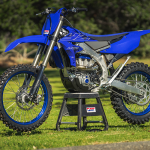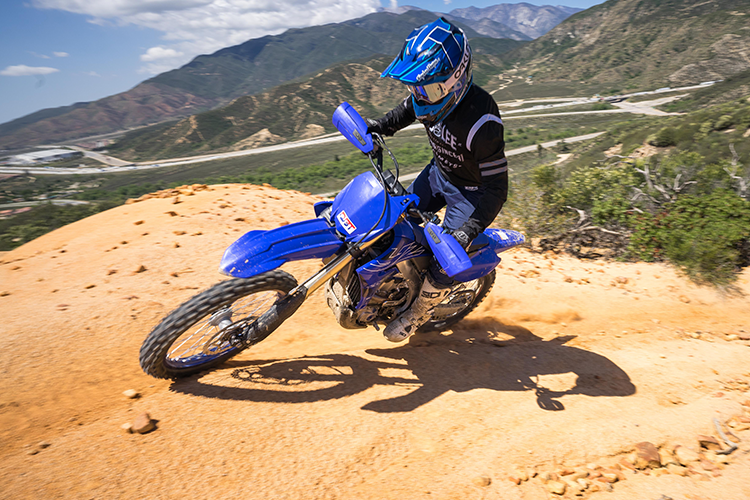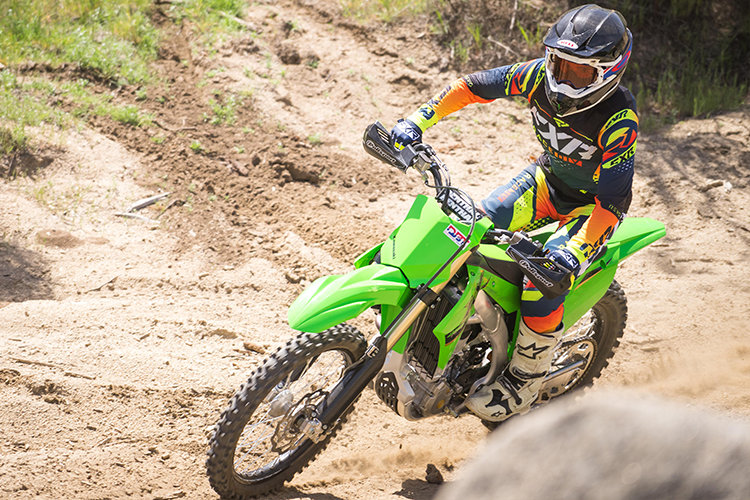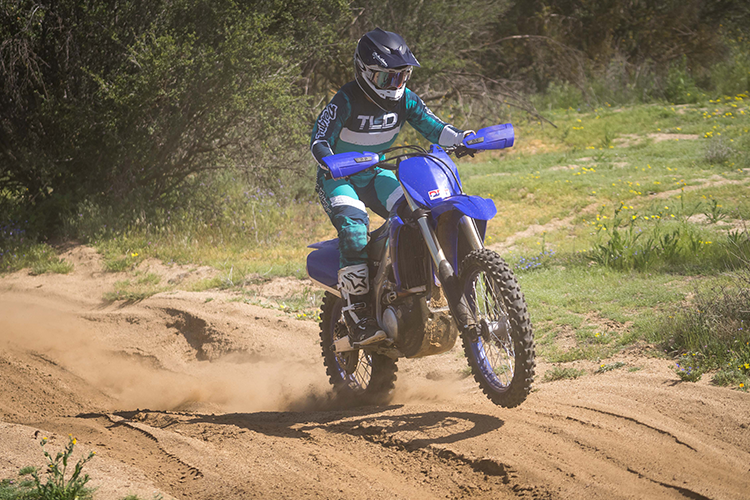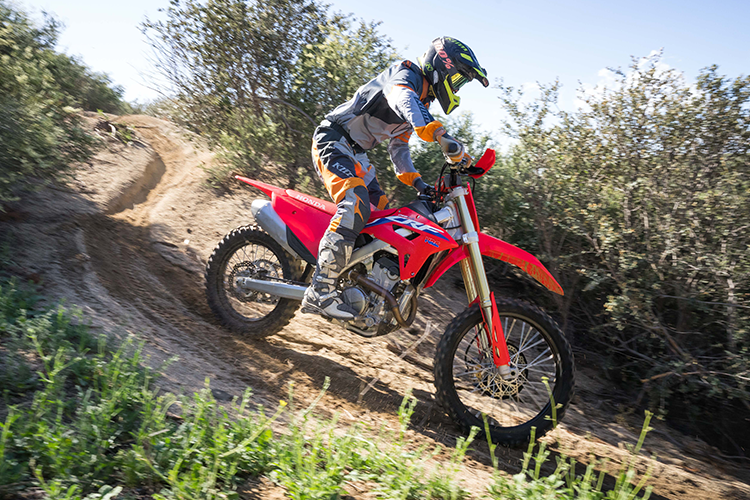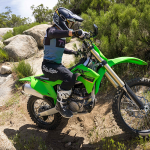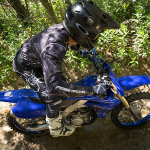Pick Your Color
Story by Trevor Hunter, Photos by Trevor Hunter
Off-road racing and riding is alive and well and all the manufacturers have taken note. What KTM started years ago, the rest of the OEMs have followed suit and now offer their own take on a competition only off-road bike, what we deem the “FX” category. Yamaha has the YZ250FX, Honda with the CRF250RX, Kawasaki brings the KX250X, and GasGas rounds out our comparison with the GasGas EX250F, a bike very similar to KTM’s 250 XC-F.
Dirt Bike Test does comparisons to accurately describe a bike’s characteristics and performance above trying to pick a winner. Declaring a true winner isn’t as applicable as some might think–preferences and feelings may not entirely align with ours, even if there is a clear cut bike that consistently ranks high for our test rider group.

To check out each bike’s First Impression, click through below:
YZ250FX | CRF250RX | KX250X | EX250F
Note: We tested each bike exactly how they come off the showroom floor – tires included. The only changes we made were clicker and sag adjustments, ECU tuning on the Yamaha with the free GYTR Power Tuner App, and added handguards for some protection. This test was performed over two days at Cahuilla Creek MX and Glen Helen Raceway, though a few of the riders have some individual time on the different bikes at various races and other off-road riding spots. We feel each machine could easily be raced in stock trim or very close to it. Some may require a little extra setup time to get acquainted with the bike, but all are potent race machines.
The Contenders
Power
Yamaha: To no one’s surprise, the Yamaha power plant is one of, if not the best in its class. It used to do all of its heavy lifting from the bottom to the mid, but updates over the past few years have made it a true contender from top to bottom. Simply put, the low-end torque is unmatched and that is much more critical in an off-road setting than on a motocross track. The motor is 350esque, allowing smooth roll-ons and picking up speed much quicker than any other bike featured here. In stock trim, it can be a little jerky at the blip of the throttle giving it a lively motor feeling. Through the mid-top, the YZF continues to pull really strong and better than ever with the latest generation motor. What makes the Yamaha motor even more impressive is the GYTR Power Tuner App and the on-the-fly mapping switch. The app allows you to really dial in the power characteristic that you really want and the map switch is very easy to use and change, even in race conditions. If a rider has an issue, some quick adjustments to the area on the easy-to-use app and generally the rider was happy.
Honda: Honda’s major overhaul for 2022 paid off with an improved motor in the CRF250RX. Coming in as what we feel is the second-best all-around motor, the CRF mimics the Yamaha in having good power and torque across the board, just slightly less of it in most areas. Without riding back-to-back with a YZF, the CRF motor really shines and is one that every rider enjoyed and felt comfortable with.
The previous generation wasn’t known to have the most torquey feel (though the RX was leaps better than the R), and the folks at Honda made more gains with the new 250F platform with a beefed-up bottom end. You truly can lug this machine down low in technical terrain and it’ll keep chugging along without a fault. As the speeds and RPMs build, it consistently pulls harder and harder. While the top end doesn’t feel quite as impressive as the last motor, it’s every bit as good, there just isn’t a big leap from the bottom to top anymore. Rather, it’s a steady, more linear climb to peak power.
The Honda mapping switch could use some work. While it is “on-the-fly” adjustable, it takes a very concentrated effort to do so, and seemingly half the time we tried it without coming to a stop, we didn’t actually switch the maps at all. With that being said, the three different maps available are all different and we came to like each map in different ways. The stock Map 1 is a good all-around map that we tend to ride in 75% of the time. It does everything well and since it is harder to select different maps, we typically leave it in this one. Map 2, or the “mellow” map, is very smooth, torquey, and easy to ride. Trail riding, we found this to be our map of choice. You can lug the bike, keep the rear wheel hooked up, and be smooth on the bike without a jerky power delivery that can get away from you in the tight stuff. Lastly, Map 3 or the “aggressive” map is fun to ride with a slightly harder hitting power down low. In faster, more open conditions some of our testers preferred this map as you could ride a gear taller through corners. Overall, all three maps work well and complement each other, but Map 1 was the most favored by our testers.
Kawasaki: The KX motor is the least off-road oriented of the bunch, though don’t let that scare you away from it. For pure racing, the aggressive power was favored by quite a few of our testers, from Pro to Novice/Intermediate, as it has competitive top-end power and is easily ridden there unlike the GasGas which can be a bit of a chore. The KX has the least amount of torque down low, but its quick-revving powerband gets it into the meat of the power quick to stay competitive. Like the GasGas, it revs to the moon and both aggressive and lazy riders alike preferred this as they didn’t need to shift much, instead just letting the RPMs build continuously. The mapping options on the KX are changed through couplers, meaning there’s no ability to change while riding. Like the Honda, there is a standard, mellow, and aggressive options and for the most part, we stuck to the standard or Green coupler, even though it comes equipped with the mellow or black coupler on the X model.
GasGas: The GasGas motor is deceiving. Initial impressions lead you to believe that it produces very little torque and no bottom end, only starting to find its legs in the mid-range before an explosive top end. While motocross and faster off-road riding will showcase this trait, the amount of torque put out in tight terrain is actually quite impressive. It’s like a hidden gem – once you find it, you want to use it more than you really should. The motor is polarizing with a very impressive torque at the slowest speeds and quite possibly the best revving motor on top end, but everywhere else is mediocre when ridden back-to-back with the Yamaha and Honda. Hyper aggressive riders enjoyed bouncing off the rev limiter looking to exploit every ounce of horsepower, while trail riding and novice riders liked the smooth pulling, easy-to-ride low end that isn’t prone to stalling or ripping your arms out. Unlike the KTM and Husqvarna, there is no mapping switch on the GasGas, though there is an accessory option available for purchase.
Where all four models differ greatly is in the transmission. The Yamaha boasts a wide-ratio, 6-speed transmission with everything from a granny first gear to a high-speed sixth gear. The gaps are all pullable and the FX motor is strong enough to pull every gear without issue. The GasGas has a MX transmission from 1-5 but has an overdrive sixth gear to reach the highest speeds. A lot of faster, race-oriented riders enjoyed the GasGas transmission from 1-5 being close and giving riders the ability to run two gears in every situation, whereas the Yamaha only has one gear for every situation due to the larger gaps. However, the Gas Gas bonus sixth gear is very tough to pull in race conditions and is more suited to trail riding than racing unless you’re hitting 80mph+ sections. The KX and CRF both carry over the exact transmissions from the MX models and are good for GP racing, but it doesn’t excel in high-speed terrain, desert, and woods terrains like the GasGas and Yamaha do.
The KX and GasGas feature hydraulic clutches while the CRF and YZF boast cable clutches – depending on the rider, a different one was favored by each.
Suspension
Off-road suspension typically is soft and mushy, heavily favoring comfort over performance. However, the recent trend with a dedicated off-road race lineup has altered how the OEMs set up their suspension and three of the four bikes in this lineup are very similar. The Yamaha, Kawasaki, and Honda all resemble a motocross-style setup with stiffer settings that are catered to more west coast GP racing. On the other end of the spectrum, the GasGas favors east coast-style terrain with a softer setting and the lone air fork. The tricky thing about production off-road suspension is that its intended use varies so widely and it is nearly impossible to find a good do-it-all setting.
Yamaha: Right away, every rider who jumped on the Yamaha raved about how well the KYB components perform across a variety of conditions. The bLU cRU is able to find small bump compliance out of the forks and shock without sacrificing bottoming performance, making it a really well-rounded package. It is the most versatile package in the bunch, and every rider said it was the best-performing suspension in our two days of riding at Cahuilla Creek MX and Glen Helen.
Honda: The Honda’s Showa components have a stiffer in nature feeling, true to Showa, but they have found more comfort in their settings in the last year or so. The CRF gravitates to more motocross than true off-road, but tuning the clickers makes a noticeable difference and gives the bike a wide range to perform. Depending on the rider and terrain, we could always find a pretty good setting, it just took a little more work with clickers and ride height than the Yamaha did.
Kawasaki: The Kawasaki KX250X opts for KYB spring components front and rear and they are equipped for speed. Like the Honda but even more so, the KX is designed for faster GP racing and motocross, and our faster riders really liked the performance of the KX. The KX has minimal movement through the stroke, giving it a firmer yet not necessarily harsh feeling. Like its motor, it doesn’t shine in tight, off-road conditions as it tends to deflect and lack some of the comfort to soak up rocks, roots, and small chop.
GasGas: The GasGas is the lone ranger in having a more traditional, softer setup – which isn’t necessarily a bad thing by any means. When the speeds are down, at times it’s one of the best working bikes. The softer settings, catered more towards a GNCC/woods setup soaks up small stuff very well. Likewise, the lightweight AER48 air fork is easy to maneuver, and adjusting the air pressure is very effective when trying to set the bike up for different skilled riders or terrains. Our faster riders were able to bump up air pressure to help increase bottoming resistance more and fine-tune the rest with clickers. Surprisingly, both ends lack the bottoming performance that the rest of the bikes have and that used to be the standout feature of an air fork. A lot of riders felt the GasGas had a lot more potential in the suspension department, it just takes more time than we had over these 1-2 days to get set up and working properly for them.
Handling
Yamaha: If there is one area where the Yamaha is more indecisive, it’s in the handling department. The bike, although it doesn’t feel its scale weight in the dirt, does feel heavier at times – especially when speeds slow down. The bike is harder to maneuver than the other three offerings with the heaviest, most planted feel of the bunch. However, when speeds increased, nearly every rider favored this as the bike stayed planted and under control a lot easier than the rest. When riding the Yamaha by itself, its slow-speed handling performance isn’t quite as apparent and not something we couldn’t adjust to, but riding these bikes back to back will show a bike’s true characteristics almost immediately. It’s a give and take in this department and the handling depends on your preferences and terrain most ridden.
Honda: The Honda has the best cornering chassis of the group. It’s stiffer in nature and you feel more of the bumps through it, but you can cut down and maneuver the CRF with ease. We did feel it lacked some in the stability department, and simple things like running a little more sag (107-108mm) and dropping the forks 1-3mm helped tremendously without giving up much cornering. The stock 2.2gal fuel tank on the CRF is the worst of the bunch, and we feel it hinders the performance of the bike. It’s very top-heavy and on the wider side, and several riders felt it when jumping on the Honda. IMS and Red Moto Racing all appear to have better gas tanks for this bike which could help the Honda a lot.
Kawasaki: The Kawasaki has a lighter front end feel that corners well, but doesn’t cut down like the Honda does. At times when there is nothing to bank off of, the front end will get vague mid-corner and can push. Likewise, it isn’t quite as stable as the Yamaha, but the chassis is forgiving and soaks up bumps better than the CRF. The KX lacks a big tank, severely hindering its mileage and how far you can go on a tank of gas, but also affecting the handling. Since the front end feels more vague than the rest, we felt putting a larger capacity tank on helped the cornering and overall handling. But in stock trim, the already thin chassis of the KX paired with a stock moto tank made the bike feel the slimmest and lightest by a country mile. It’s very lively and active and you generally feel very in control of the bike with it being responsive to movements and weight shifts through the pegs.
GasGas: The GasGas is the only steel-framed chassis in the group and many riders liked it. Paired with the softer suspension, it offers a lot of comfort to the rider. The light scale weight definitely shows up on the track, but at times it led to a skatey bike that liked to dance and move around a lot. The consequences of having a lightweight bike, but you reap the rewards when turning, flicking, sliding, and looking for an agile setup where you can put the bike where you want it. It sits on the opposite side of the spectrum as the Yamaha, shining where the Yamaha lacks and faltering where the YZFX performs best.
Notable Highlights
Yamaha: A few things stand out on the Yamaha, both good and bad. In general, the rider cockpit on the Yamaha is disliked for being small and cramped, with taller and narrower handlebars, a pocketed seat, and a close seat-to-peg ratio. Smaller riders actually liked this, but most average-sized riders would benefit from a taller seat and different handlebars. Another con the Yamaha faces is it’s hard to start. The last few years has seen a hard starting YZ250F/FX and this year is no different. It hurts on dead engine starts and is just annoying when out riding or racing and you need to re-fire the bike. The Yamaha arguably has the worst brakes out of this bunch, though they still aren’t bad, just not quite on the level of the other bikes. The Yamaha skid plate is the best stock plate in the bunch. The Yamaha air filter is easy to service, 2nd best in class. Coming stock with MX33 tires front and rear was appreciated by most of our riders. The softer sidewall and performance of the tires is a plus over the usual AT81 tires.
Honda: The Honda cockpit, aside from the bigger tank, is very easy to adjust to and is another favorite amongst these riders. The Honda front brake is very touchy and powerful, something riders either loved or liked. The back brake is also touchy and we found ourselves stalling the bike quite a bit more than expected due to this. The past CRF250RX had some overheating and clutch durability issues, but we’ve found no evidence of this with the improved power and upon looking at the clutch components internally, they appear to be some of the strongest to come stock from a Japanese OEM. The CRF is the only bike to come stock with handguards (and the KTM), but its skid plate is barely enough to deflect some roost off the front tire. The CRF air box is cramped and funky, but is better with time as you learn it.
Kawasaki: The Kawasaki received a lot of praise for its ergonomics including seating position, handlebars, and rider triangle. Nearly every rider we’ve had to test this bike raves about how comfortable they feel immediately upon sitting on the bike. With that being said, nearly every rider has disliked the stock clutch lever and more so front brake lever on the KX. They are thin and very uncomfortable – to the point where it stood out and made some riders not want to use or touch either lever. Also, the stock Kawi grips are rock hard and nearly impossible to remove. The KX doesn’t come with handguards and like the Honda, the skid plate is nearly non-existent. The stock kickstand is more than bulky and like the levers, stood out to every rider in a bad way. Air filter maintenance is a pain on this and we typically found ourselves cleaning dirt out of the airboot after every filter removal.
GasGas: The GasGas cockpit is very neutral – no one complained but no one was overly impressed, it just gets the job done. The Brembo brakes are a standout and pieces like stainless steel brake lines are a nice touch. The EX250F doesn’t come with a skid plate or handguards stock (KTM comes with handguards). The GasGas air filter, and most maintenance in general, is just simpler and easier on the GasGas.
Conclusion
In general, the Yamaha and the GasGas are the most different from their MX counterparts. The biggest changes are the six-speed transmissions, while also boasting off-road specific suspension settings, ECU settings, and the usual gas tanks, kickstands, 18 inch rear wheels, etc. The Kawi is the least changed with really just an 18 inch rear wheel, kickstand, and slightly softer suspension making the change.
If there is anything we’d like to see on all these bikes moving forward, off-road ready skid plates and handguards would be easy, welcomed additions. This is a bigger task, but six-speed transmissions across the board, no matter the configuration, would be nice in the faster west coast conditions. This only applies to the KX, but a larger capacity tank coming stock wouldn’t hurt, though a lot of serious racers will often replace the stock tanks with quick-fill ready options.
While these bikes are all advertised as “off-road” bikes, they are all more than capable on a motocross track. And in some instances, they are better for consumers than the dedicated motocross model. Vet and novice riders alike can find the value of slightly softer suspension and easier-to-ride power when riding on motocross tracks and frequenting off-road trails.
The best bike for you is here, you just have to assert your priorities and preferences to determine what bike that is.
Do You Like DBT Bringing You Fresh Content? Search and Shop Through the Links Above or Below:
Get notified about new releases and stay up-to-date with the latest tests from DirtBikeTest.
By submitting this form, you are consenting to receive marketing emails from: . You can revoke your consent to receive emails at any time by using the SafeUnsubscribe® link, found at the bottom of every email. Emails are serviced by Constant Contact

